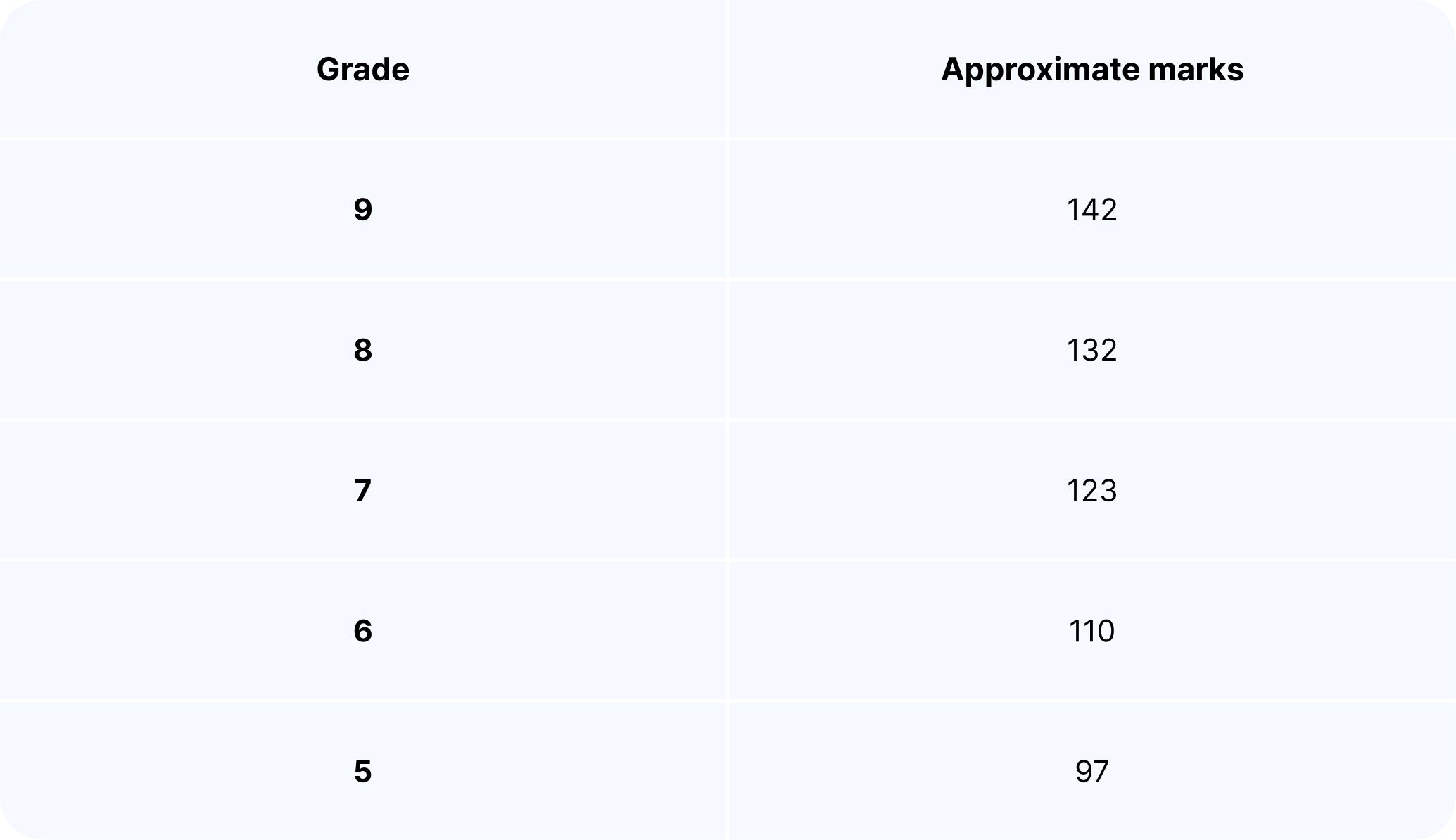Contents
Set yourself up for success in your Edexcel GCSE English Language exam - take a look at our ultimate guide to get all the information you need.
From understanding what the exam looks like to what marks you need to aim for to reach your target grade, getting prepared early will help you feel more confident in the exam hall. Read on for more.
Not sure which exam board your school uses? Take a look at our guide to finding out which exam board you’re studying.
Key takeaways:
The Edexcel GCSE English Language exam consists of two written papers and a non-exam speaking assessment.
The papers are 1 hour and 45 minutes (Paper 1) and 2 hours 5 minutes (Paper 2) and contribute 40% and 60% of your grade each.
GCSE grade boundaries are set after the exam. Take a look at last year’s boundaries below.
What’s the format of the Edexcel GCSE English Language exam?
The Edexcel English Language exam consists of the following:
Two externally assessed written papers with a total of 160 marks available.
Paper 1 lasts 1 hour and 45 minutes, has 64 marks available and counts for 40% of your final grade.
Paper 2 is 2 hours and 5 minutes, worth 96 marks and 60% of your final grade.
There is also an internally assessed spoken language assessment that does not contribute to your final grade.
What’s the difference between Papers 1 and 2 for Edexcel English Language?
The two papers test you on different parts of the English Language curriculum.
Paper 1: Fiction and imaginative writing
Paper 1 is split into two sections:
Section A focuses on reading: You’ll be asked to analyse provided extracts from a 19th-century text, focusing on how the language and structure communicate the text's themes.
Section B focuses on imaginative writing: You’ll be asked to write a piece based on a prompt provided in the paper.
Take a look at the Edexcel English Language Paper 1 from May 2024 to learn more.
Paper 2: Non-fiction and transactional writing
Similar to Paper 1, the second exam is split into two parts, with a focus on reading and then writing:
Section A focuses on reading two 20th/21st-century non-fiction extracts provided: You’ll be asked a series of questions asking you to analyse the extracts and to compare them.
Section B focuses on transactional writing: You’ll be asked to write a non-fiction piece, such as an article or blog.
Take a look at the Edexcel English Language Paper 2 from May 2024 to learn more.
What are examiners looking for?
Examiners are assessing both your reading comprehension skills and your ability to write in different formats.
The assessment objectives for Edexcel English Language are:
AO1: Identify and interpret explicit/implicit information, select evidence.
AO2: Explain, comment on, and analyse how writers use language/structure to achieve effects.
AO3: Compare ideas and perspectives across texts (especially in Paper 2).
AO4: Evaluate texts critically; for writing, produce coherent, effective writing with accuracy.
Examiners are looking for you to show your reading and writing skills throughout this exam. Remember to think about structure, form and to read through your answers carefully to make sure they’re accurate.
Find out more about what examiners are looking for by taking a look at previous Edexcel GCSE English Language mark schemes.
What are the grade boundaries for Edexcel GCSE English Language?
It’s important to remember that the exact grade boundaries for your GCSE exams will change every year. Exam boards adjust the grade boundaries after an exam has happened, depending on how advanced the exam content was and how the cohort performed.
This is so students don’t have an advantage or disadvantage because of the year they took the paper. For example, if your paper were harder, grade boundaries would be lowered so that a grade 5 reflects the same level of knowledge as in previous years.
To give a sense of what to expect, here are the grade boundaries for 2024’s Edexcel English Language GCSE:

While we can’t say the exact boundaries for the next exam, this should give you an idea of what marks to aim for to hit your target grade.
How can I prepare for GCSE English Language?
Here are 5 top tips for preparing for your GCSE English Language exams:
1. Master your analytical skills
A key area that GCSE English Language tests is your ability to analyse and understand texts.
Every time you read a text, annotate it for metaphors, similes, alliteration, rhetorical questions, and tone. Make sure to look at the structural choices, too.
Always ask yourself; Why did the writer do that? What effect does it produce for the reader?
Remember to back up your analysis with quotes and explain the impact of these devices.
Top tip: Try teaching others what you know about a text to help build confidence in your understanding.
2. Practise writing little and often
English Language exam questions ask you to answer a variety of questions, including essays, and to write your own pieces.
Practise writing PEE/PEEL paragraphs (Point, Evidence, Explain, Link) as a clear way to structure your thoughts.
Use past papers and practise writing answers under timed conditions.
Focus on analysing the texts. Think about how language, structure, and form create meaning.
Practise creative writing using prompts and get feedback from your teacher or friends to help you improve.
Top tip: Use practice papers under timed conditions to get used to planning and writing clear answers.
3. Don’t forget to practise comparing and contrasting
In both papers, you’ll be asked to compare and contrast texts. It’s a good idea to practise this and get used to drawing parallels between different source materials.
Practise comparing vocabulary, tone, viewpoint, structure, and the effects of these on the audience.
Think about how you structure your comparisons to keep your writing clear and easy to understand.
Top tip: Colour code your notes to help organise your thoughts and make them easier to digest.
4. Practise with past papers and mark schemes
Testing your skills with past papers is a great way to build speed, accuracy and confidence. Incorporate test questions into your revision routine to help put your learning into practice.
Practise writing plans for answers and outlines for essays to build a strong habit.
Try taking the full exam, working through it in your own time and noting which sections you found easiest and most challenging.
Top tip: Take a look at our guide to revising with past papers.
5. Mimic test conditions
Set yourself up for success by practising in exam conditions to get used to working quickly and with full focus.
Try to sit a full paper under timed conditions, without your notes or texts.
Afterwards, mark your own work using the Edexcel marking criteria or swap with a friend and mark each other.
Reflect on the process: How did you manage your time? Did you plan before writing? Which areas do you need to work on?
Top tip: Break down each question into chunks and set yourself enough time to answer each section.
For more revision top tips, check out our blog on GCSE study habits to build.
Understanding what your GCSE English Language exam looks like for your exam board is a great start to your revision. Don’t forget to bookmark this blog to refer back to along the way. Best of luck!
Don’t miss Atom’s GCSE giveaway!

Six months. Six epic prizes. Six chances to make the GCSE season unforgettable.
We’re launching Atom for GCSE prep in 2026, and to celebrate, over the next six months, we’re giving away thousands of pounds worth of prizes to help your child level up their GCSE revision.
Here’s a taste of what’s up for grabs:
The latest Apple tech, including an iPad Air, Vision Pro and more
Festival tickets for Boardmasters and Reading 2026
Europe interrail passes and £1,000 spending money
…and that’s just a few of the amazing prizes available.
Our September winner has already taken home an incredible prize! Find out who it was and what they won in our latest giveaway update.
It’s free to join. UK only. Full T&Cs apply.
Contents
